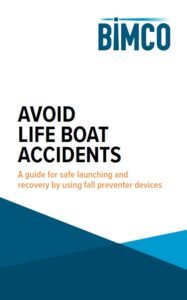BIMCO has developed new guidance for seafarers on the safe launching and recovery of lifeboats using fall preventer devices (FPDs), aiming to reduce the number of seafarer fatalities and injuries.
Despite efforts in recent years to reduce fatalities related to lifeboats, this kind of incidents remains too frequent. Most of the accidents happen in boats using conventional davits and on-load release systems. However, recently other parts of the suspension and lifting systems have been identified as points of failure too, particularly the wire rope falls on larger lifeboats.
The IMO recommends the use of FPDs because so many recent lifeboat and rescue boat accidents have resulted in fatalities and injuries to seafarers. The use of FPDs is intended to be an interim measure to reduce this risk, while new, safe IMO approved systems are developed. However, this process will take some years, and so FPDs are recommended for the intervening time until approval is secured.
The new guidance, entitled ‘Avoid Lifeboat Accidents’, advises on how to prevent accidents with lifeboats and rescue boats equipped with on-load release systems, informing of whether additional precautions in the form of FPDs are appropriate, and if so, when and how to use them safely and effectively when launching and recovering the boat. Other failure devices, and new innovative hook systems are examined too.
Launching lifeboats
- Before starting : While the boat is still in its stowed position, you should ensure that the FPDs are attached, or connected correctly.
- Swing-out for boats with outboard boarding 2 arrangements : The boat is released from constraints such as gripes and
swung out. Tricing pendants are rare in modern enclosed boats. The boats on cargo ships are normally arranged to be boarded in the stowed position and if so, they would not have tricing pendants. On a cargo ship the boat normally can be lowered without further release actions. - Water’s edge : When the boat reaches the water, or is a safe distance (less than one metre) above it, you may remove the FPDs.
- FPDs disconnected : Once FPDs are removed and the boat is waterborne you can release the hook.
If the hook releases prematurely, FPDs will be under load and should remain in place until the boat becomes waterborne. They may then be removed as the load is relieved. Disconnection in an emergency could be achieved by cutting the FPD if the load remains, but extra care should be exercised in such circumstances to ensure the boat is waterborne before the FPD is cut.
Aron Sorensen, Head of Maritime Technology & Regulation at BIMCO said:
“We have seen too many accidents with lifeboats resulting in fatalities and injuries. This pamphlet provides the master and crew with solid, experience-based advice on the use of fall preventer devices (FPDs) during lifeboat operations. We sincerely hope that this pamphlet can help to reduce and avoid such tragic accidents in the future”.
Explore more by reading the full report:


































































I am sure BIMCOs full report will be just as interesting as this summary. I have gone through it briefly and I find the theme is all about launching lifeboats, with FPDs attached, in calm sea conditions. In my opinion, it does not seem to address the practicalities of heavy-weather launching, i.e. conditions under which lifeboats are used to evacuate the crew – where liferafts are not used, for whatever reason.
For example, how would one be able to gauge the ‘water’s edge’ situation in heavy seas (real life scenario): “When the boat reaches the water, or is a safe distance (less than one metre) above it, you may remove the FPDs.”?